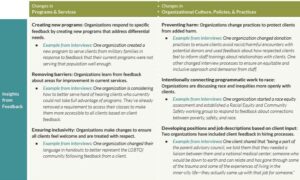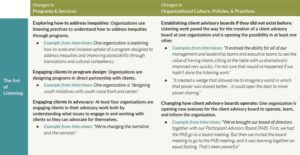Juan Clavijo | Feb. 18, 2022
Children’s Law Center, a legal services and advocacy organization based in Washington, D.C., began implementing high-quality, client-focused feedback loops in partnership with the capacity-building program Listen4Good in 2017. Since then, feedback has informed adjustments to programming that have improved how the organization serves its clients and influenced how staff and leadership view clients and include them in decision-making. For example, members of a new client advisory board participated in the development of an initiative called the Build Health Collaborative, ensuring that the program be responsive to clients’ needs and preferences. Describing how feedback efforts have contributed to more power-sharing, one staff member said, “When we started Listen4Good, I would never have said that Children’s Law Center in any short period of time would have had clients at the table and sharing that decision-making power and leading the Build Health Collaborative. [Feedback work] evolved the ability for all of our management, leadership, and executive teams to see the value of having clients sitting at the table with us. I’m not sure that would’ve happened if we hadn’t done the listening work.”
Like Children’s Law Center, more and more nonprofits in the United States are implementing high-quality feedback practices that help them to meaningfully engage with clients. At the same time, many foundations and nonprofits have moved further along in addressing systems and structures that produce inequitable outcomes. As these practices and conversations evolve in the sector, there has been increasing interest in understanding the connection between feedback and equity. ORS Impact partnered with Children’s Law Center and five other nonprofits implementing high-quality feedback loops through Listen4Good to explore this relationship and share practical examples and lessons with the field.
Our work with these organizations suggests that feedback can, in fact, contribute to organizations’ equity work in two main ways: (1) insights from feedback can inform changes in programs and organizational policies that advance equity, and (2) the act of listening itself can influence organizational change, including in how organizations understand, build, and share power with clients. Table 1 shows examples of the ways in which feedback has contributed to equity-related changes in the six organizations we worked with.
Table 1 | Changes Resulting from Feedback and Listening Practices


Lessons for the Field
Nonprofits, funders, and partners working to meaningfully engage the people at the heart of their work and advance equity can consider the following observations gleaned from our work with the six partner organizations.
- High-quality feedback can be a first step to include clients’ voices in guiding equity work. Efforts to understand and address inequities are complex and unique for every organization. However, high-quality feedback can act as a starting point for organizations that want to move further along their equity journey. It can uncover new ways of partnering with clients and identify specific practices that help organizations play their part in advancing equity.
- Not all feedback and listening practices are created equal – their design influences what they yield. Before designing listening practices, organizations should have a clear learning agenda tied to their equity work. The learnings they need to advance those efforts should inform which mechanisms to use when engaging clients.
- Nonprofits cannot do this work alone. Both high-quality feedback and intentional equity work take resources and expertise. Funders play an important role in ensuring that nonprofits have the necessary support to do this well.
A New Report
We turned our findings, including the types of changes organizations shared with us (Table 1) and the lessons for the field just outlined, into a new report, “Feedback and Equity: Connecting the Dots.” The report attempts to clarify the conceptual connection between feedback and equity by identifying examples and patterns of practices. It also offers a framework for thinking about how to leverage listening and feedback practices as a catalyst, mirror, or compass for an organization’s equity journey. We hope the report contributes to lessons and learnings for nonprofits, funders, and other partners in the field who are increasingly turning to clients as they work to create a more equitable and just society.







